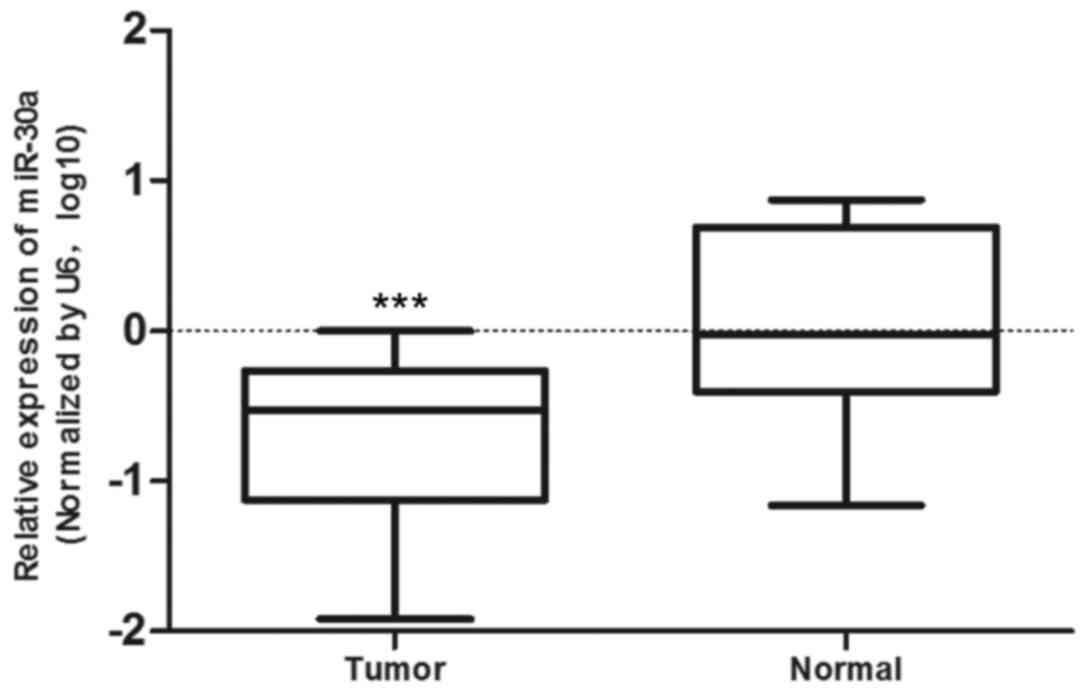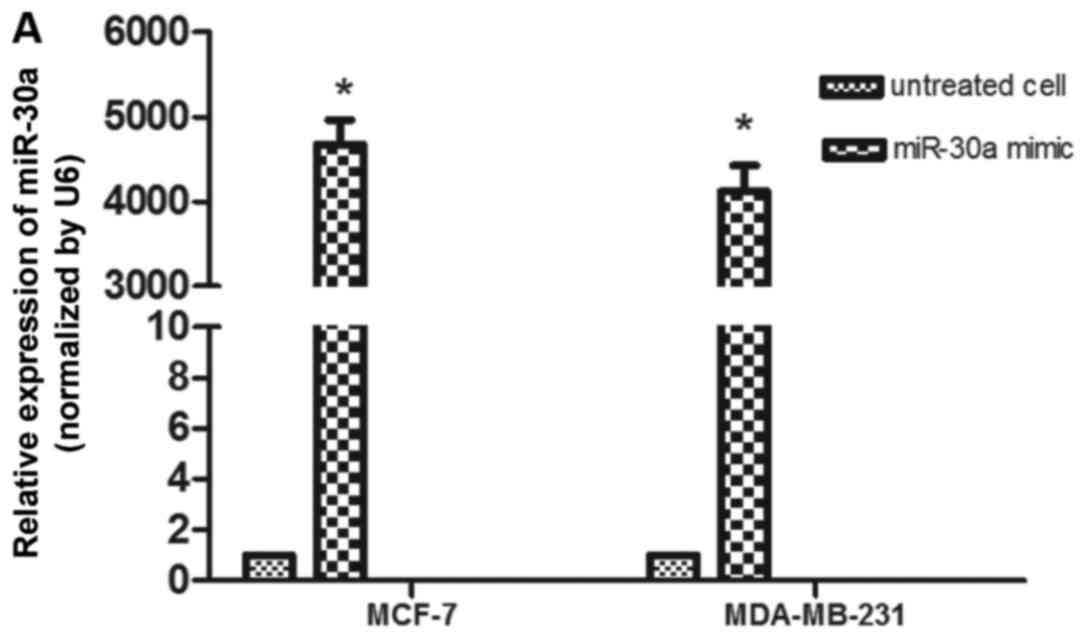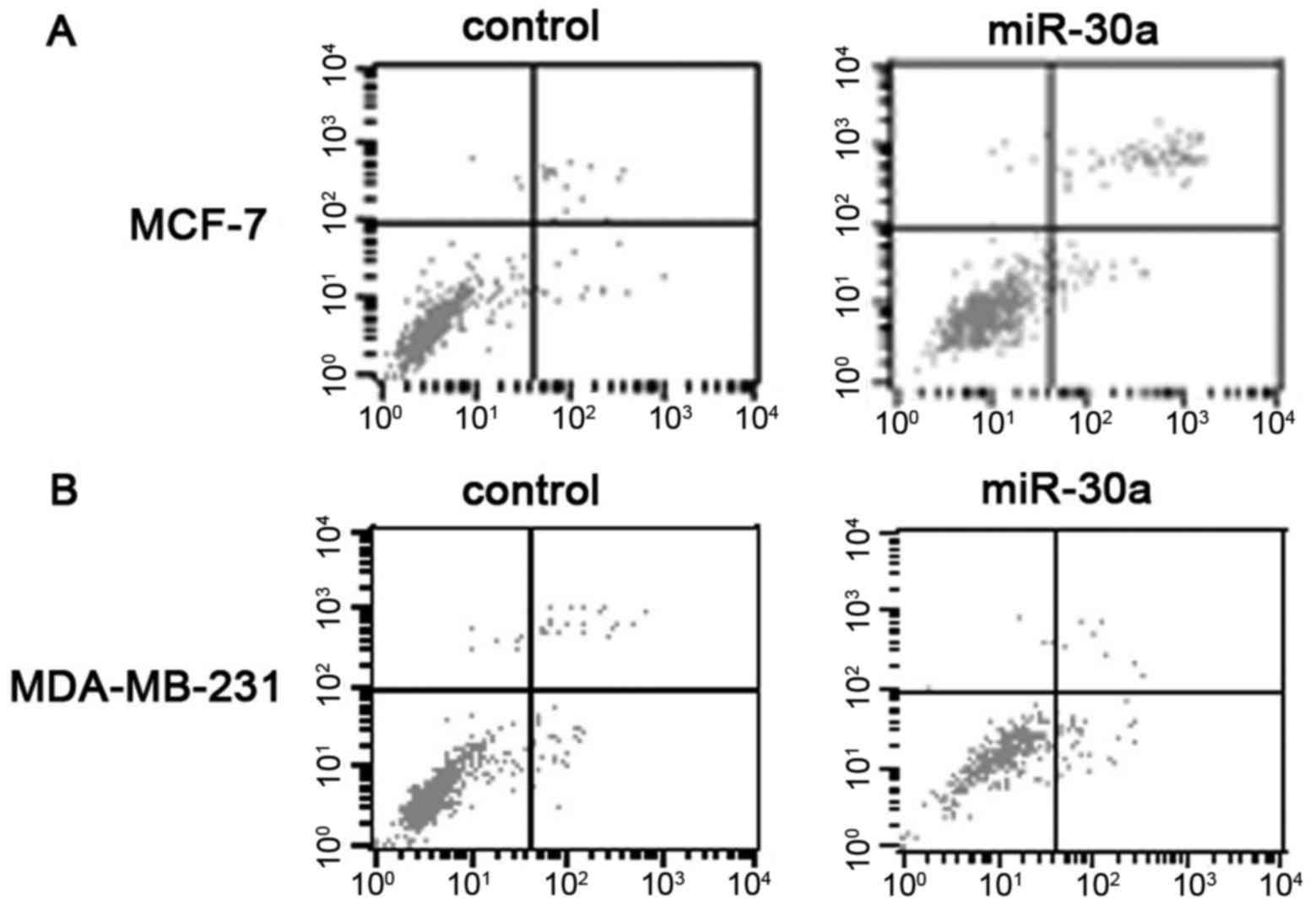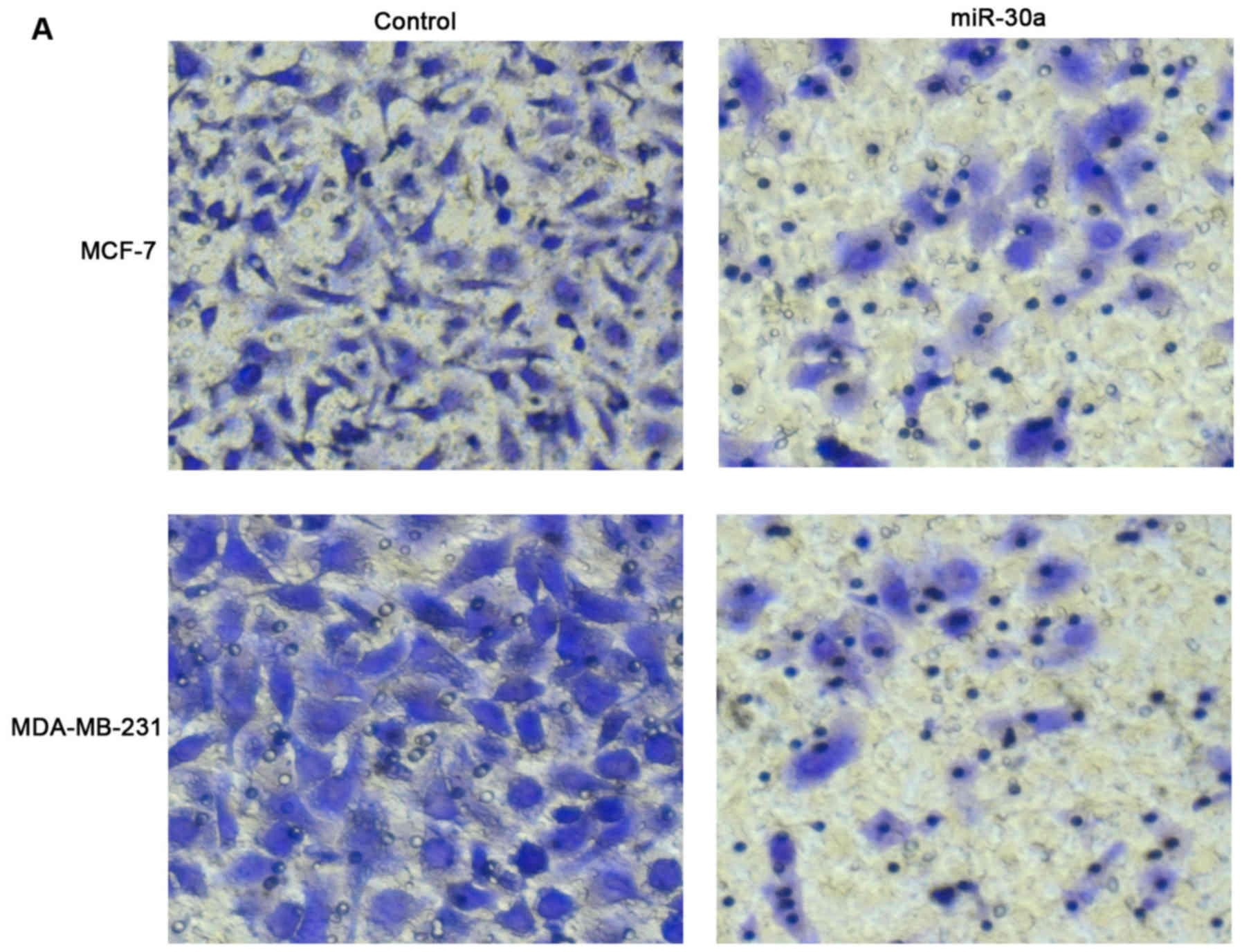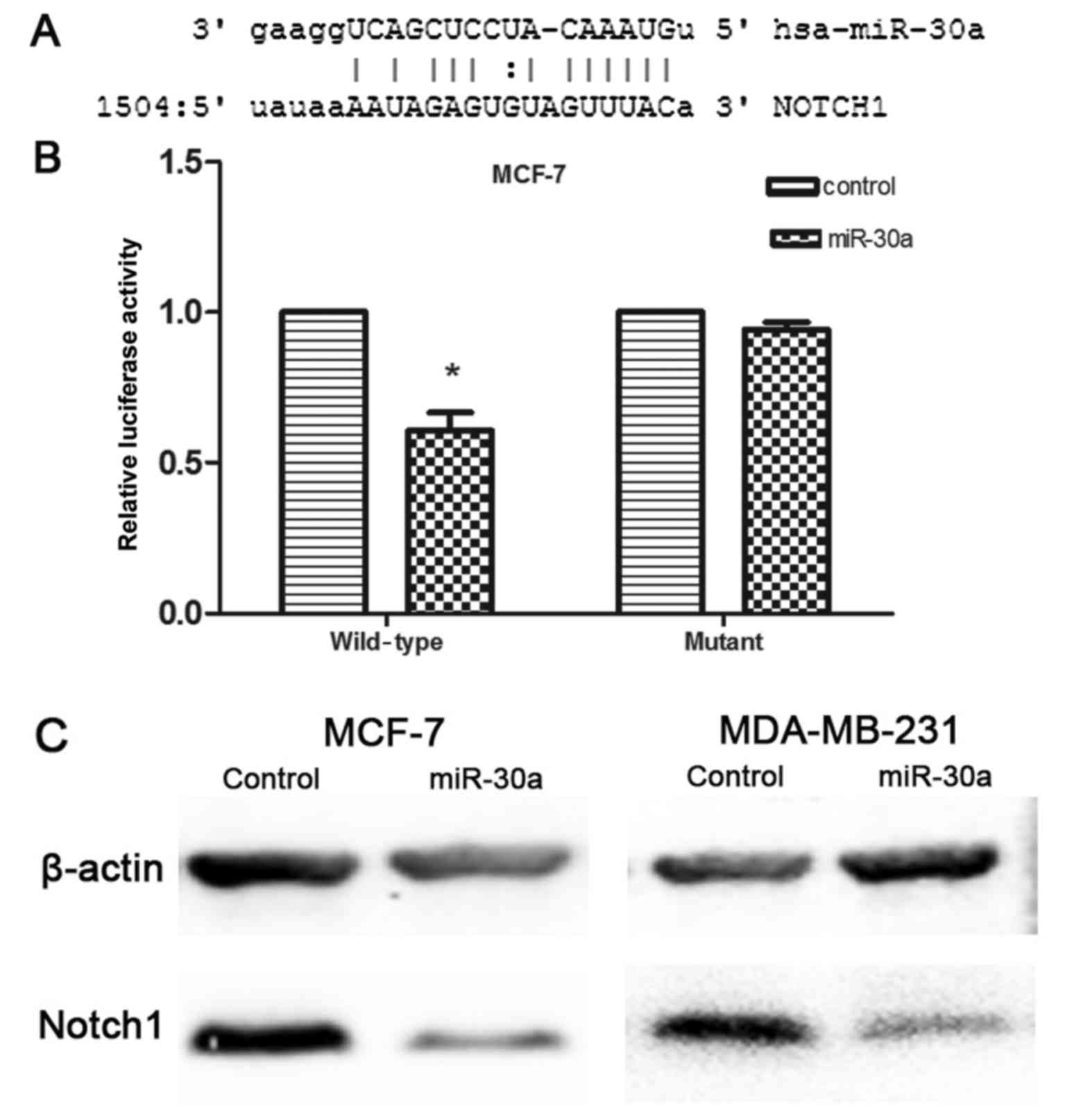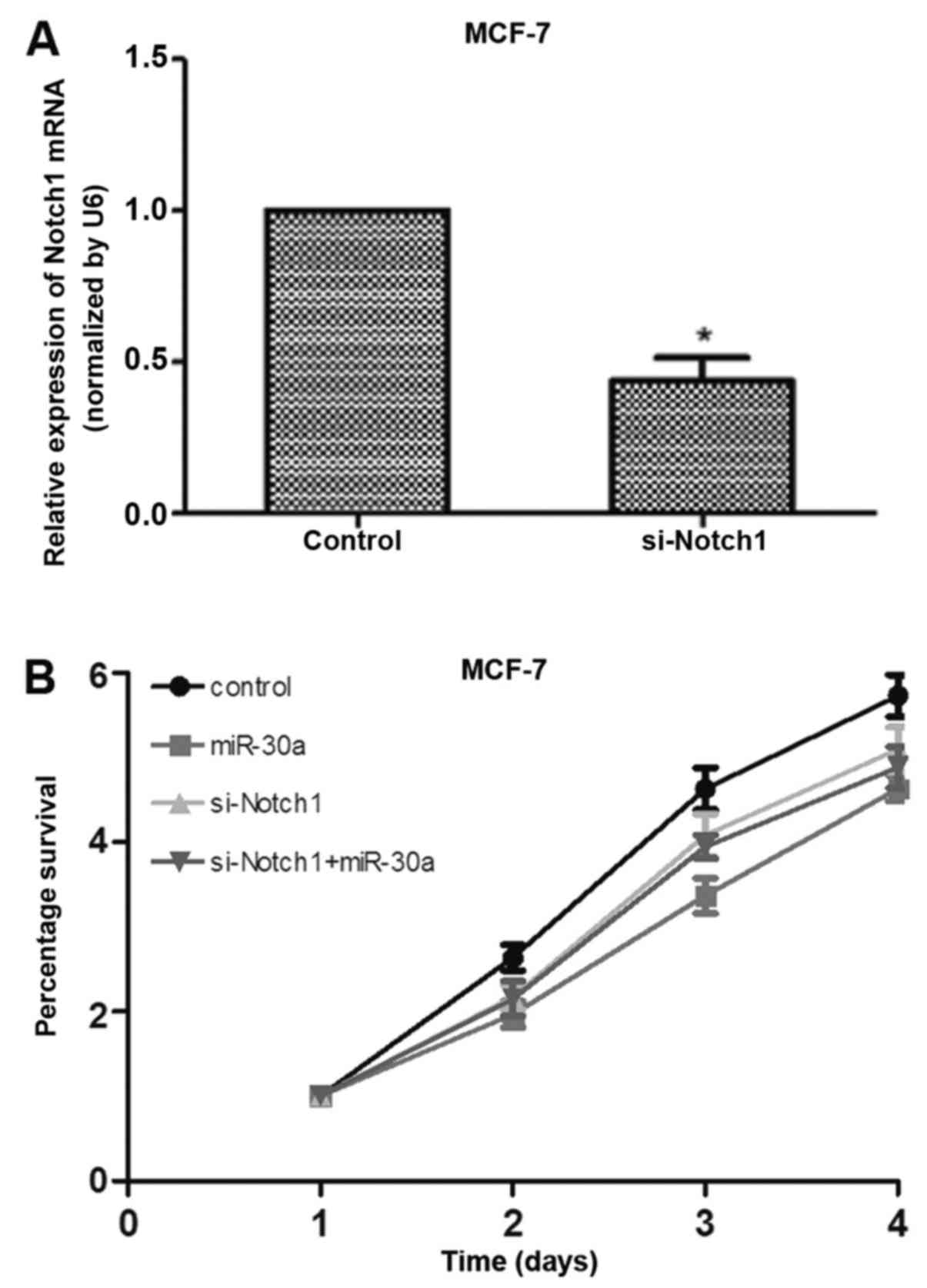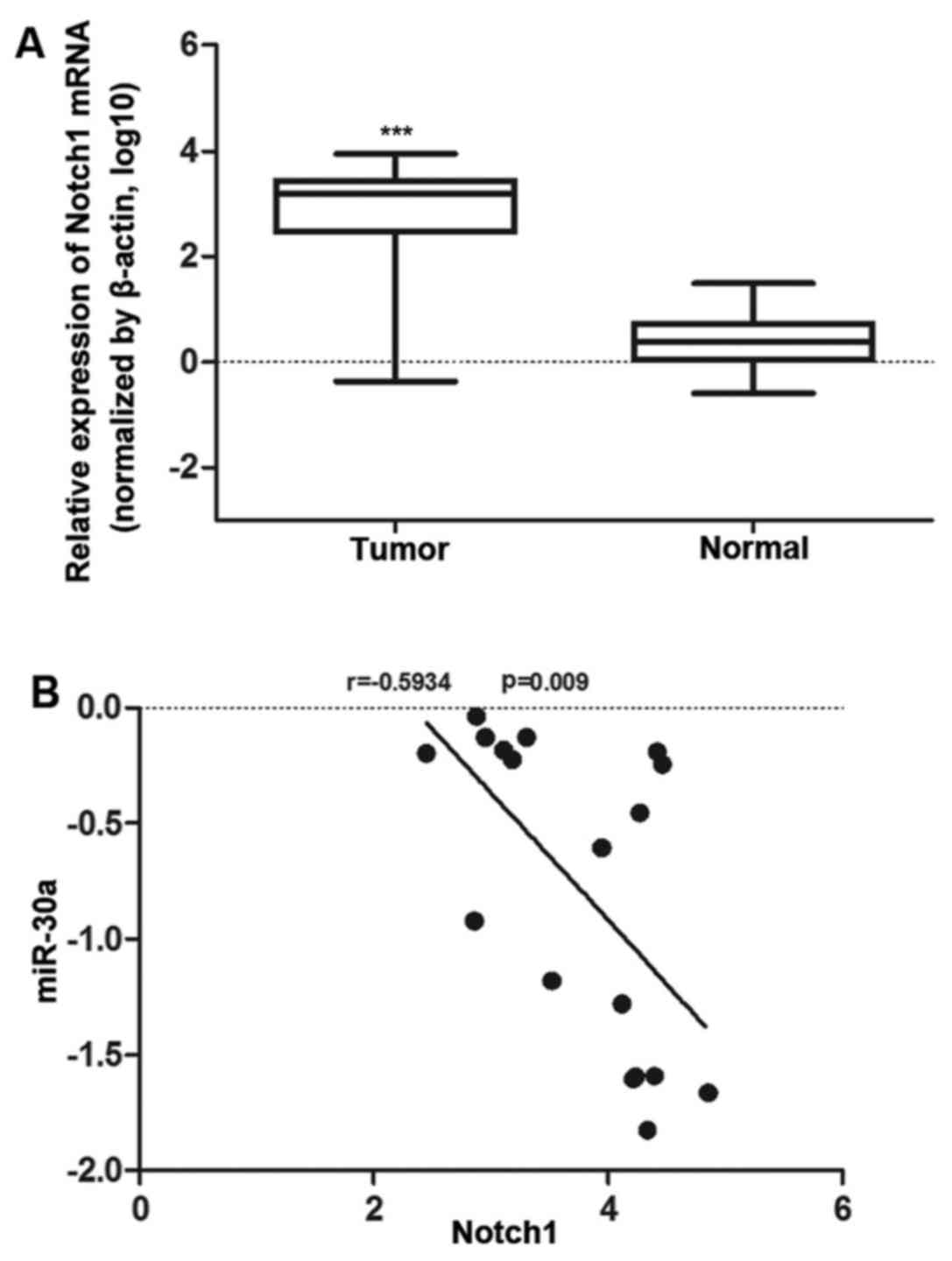miR-30a inhibits the biological function of breast cancer cells by targeting Notch1
- Authors:
- Published online on: July 31, 2017 https://doi.org/10.3892/ijmm.2017.3084
- Pages: 1235-1242
Abstract
Introduction
Breast cancer is the most common type of cancer affecting women and a leading cause of mortality for females world-wide (1,2). However, several studies have reported that microRNAs (miRNAs or miRs) are involved in regulating gene expression, as well as regulating diverse physiological and pathological processes (3,4). miRNAs are short, highly conserved small non-coding RNA molecules of 19–25 nucleotides in length that regulate gene expression at the post-transcriptional level. By targeting complementary binding sites within the 3′ untranslated region (3′UTR) of target messenger RNAs (mRNAs), they impair or inhibit translation and promote degradation (5–8). Similarly, miR-30a is situated on chromosome 6q.13 and is produced by an intronic transcriptional unit (9,10). Two mature forms of miR-30a exist, miR-30a-3p and miR-30a-5p. miR-30a is deregulated in several malignant tumors, such as breast cancer (11), hepatocellular cancer (12), colon cancer (13), nasopharyngeal carcinoma (14), prostate cancer (15), endometrial cancer (16) and cutaneous squamous cell carcinoma (17). Moreover, miR-30a has been shown to be a potential prognostic marker in breast cancer (18).
The Notch signaling pathway is highly conserved and plays an important role in intercellular signaling and developmental processes; it includes NOTCH ligands (JAG1, JAG2, DLL1, DLL3 and DLL4) (19,20), Notch receptors (Notch1, −2, −3 and −4), and the downstream target genes, hairy and enhancer of split-1 (HES1) and cyclin D1, and FADD-like apoptosis regulator (CFLAR) (21–23). Previous studies have confirmed that the overexpression of Notch1 is associated with cancer, particularly breast cancer, cancer cell proliferation and apoptosis, as well as the promotion of migration and invasion (24,25).
However, the function and mechanisms of action of miR-30a in breast cancer are not yet fully understdood, nor is its association with the Notch1 target gene. Thus, in this study, we aimed to shed light into this matter. We propose a logical hypothesis: miR-30a may mediate Notch1, and thus regulating its biological function.
Materials and methods
Cell culture
The human breast cancer cell lines, MCF-7 and MDA-MB-231, were purchased from the American Type Culture Collection (ATCC, Rockville, MD, USA). All cell lines were cultured in RPMI-1640 (Keygen, Nanjing China), supplemented with 10% fetal bovine serum (FBS; Gibco-Life Technologies, Carlsbad, CA, USA) and kept in a humidified atmosphere containing 5% CO2 at 37°C.
Cell transfection
Human hsa-miR-30a mimic and hsa-miR negative control were purchased from Genepharma (Shanghai, China). Small interfering RNA (siRNA) against human Notch1 (si-Notch1), negative control siRNA (NC-siRNA) and si-h-GAPDH were purchased from RiboBio Co., Guangzhou, China. At 24 h prior to transfection, the MCF-7 and MDA-MB-231 cells were plated in 6-well plates (2.5×105 cell/well), and then transfected with miR-30a mimic (at 100 nM final concentration; Genepharma), or miR negative control (100 nM; Genepharma) using Lipofectamine 2000 (Invitrogen, Carlsbad, CA, USA). NC-siRNA at 100 nM, si-Notch1 or si-h-GAPDH were delivered into the cells following the manufacturer's instructions. The cells transfected with the miRNA mimic or siRNA were harvested 12–48 h post-transfection.
Reverse transcription-quantitative PCR (RT-qPCR)
Total RNA was extracted using TRIzol® reagent (Invitrogen). RT-PCR was carried out using the TaqMan® MicroRNA Reverse Transcription kit (Applied Biosystems; Life Technologies, Carlsbad, CA, USA). Mature miRNA was spotted using the TaqMan® MicroRNA assay kit (assay ID: miR-30a: 000417 and RNU6B: 001093) (Applied Biosystems; Life Technologies). All procedures were performed according to the manufacturer's instructions. The primers used were as follows: Notch1 forward, 5′-CACTGTGGGCGGGTCC-3′ and reverse, 5′-GTTGTATTGGTTCGGCACCAT-3′. Relative expression levels were calculated using the ΔΔCt method and normalized to RNU6B expression (fold difference relative to RNU6B). The quantitative analysis of the changes in expression levels were calculated using the ABI 7300 real-time PCR machine (Applied Biosystems). All reverse transcription and PCR assays were carried out in triplicate.
Cell proliferation assay
At 24 h following the transfection of miRNA mimics, the cells were seeded into 96-well plates (5×103 cells/well). Subsequently, 10 µl of cell counting kit-8 assay solution (CCK-8; Dojindo, Kumamoto Prefecture, Kyushu, Japan) were added to the cultured cells in 100 µl of culture medium and incubated in a humidified atmosphere for 1 h at 37°C; each experiment was performed in triplicate. The absorbance was measured at 570 nm using CliniBio 128 (ASYS-Hitech, Eugendorf, Austria).
Cell apoptosis assay
The MCF-7 and MDA-MB-231 cells were transfected with miR-30a mimic or negative control for 48 h. Subsequently, the cells were trypsinized and collected by centrifugation at 1,000 rpm for 5 min. The cell pellets were rinsed twice with ice-cold phosphate-buffered saline (PBS). Apoptosis was determined by dual staining using the FITC Annexin V apoptosis detection kit I (BD Biosciences, Franklin Lakes, NJ, USA) according to the manufacturer's instructions. The experiment was carried out in triplicate.
Cell migration assays
To examine cell migration, tissue culture inserts (6.5 mm diameter) with an 8.0 µm pore size (Transwell; Corning, Inc., Corning, NY, USA) were placed into the wells of 24-well culture plates, separating the upper and the lower chambers. The cells transfected with either miR-30a mimics or negative control miRNA were cultured in 6-well plates, and the cells were starved for 24 h. The cells (1×105 cells/well) suspended in 200 µl RPMI-1640 serum-free medium were added to the upper chamber and 600 µl RPMI-1640 medium supplemented with 20% FBS was placed into the lower chamber. Following 24 h of incubation in a humidified atmosphere, the cells that migrated through the Transwell membrane were fixed in 4% paraformaldehyde, stained with crystal violet (Beyotime, Shanghai, China), and 4 random fields were counted under a microscope (magnification, ×100; CFM-500; Carl Zeiss, Göttingen, Germany).
Cell invasion assay
Cell invasion was carried out using Matrigel® Basement Membrane Matrix (Corning, Inc.). The cells transfected with either miR-30a mimics or NC miRNA were cultured in 6-well plates and then starved for 24 h. The cells (1×105 cells/well) suspended in 200 µl RPMI-1640 serum-free medium were added to the upper chamber and 600 µl RPMI-1640 medium supplemented with 20% FBS was placed into the lower chamber. Following 24 h of incubation, the cells that had invaded the Matrigel membrane were fixed in 4% paraformaldehyde, stained with crystal violet, and 4 random fields counted under a microscope (magnification, ×100). The experiment was performed in triplicate.
miRNA target gene identification
The prediction of miRNA target genes was carried out using TargetScan (http://www.targetscan.org), Pictar (http://pictar.mdc-berlin.de), microRNA (http://www.microrna.org).
Dual luciferase activity assay
The wild-type and mutant seed region of Notch1 containing the putative target site for Pre-miR-30a was synthesized and cloned into the PGL3-promoter vector (Life Technologies). The MCF-7 cells (5×104 cells/well) were incubated in 24-well plates. miR-30a mimic or control mimic, PGL3-Notch1 3′UTR-WT vector or PGL3-Notch1 3′UTR-MUT vector containing Firefly luciferase reporter gene and 3′UTR of Notch1 gene (Promega, Madison, WI, USA) were co-transfected into the cells using Lipofectamine 2000 (Invitrogen). After 48 h of transfection, luciferase activity was analyzed by using the Dual Luciferase Reporter assay system (Promega) and normalized to Renilla luciferase activity.
Western blot analysis
Total protein was extracted and lysed using RIPA buffer (Beyotime). Equal amounts of protein were separated by NuPAGE® LDS Sample Buffer (4X) and NuPAGE® Reducing Agent (10X) (both from Life Technologies). A total of 20 µl protein from each sample was used for western blot analysis. Initially, protein samples were separated using a 5% MOPS SDS running buffer (20X) (Life Technologies), and they were subsequently transferred onto polyvinylidene difluoride membranes (Sigma, Deisenhofen, Germany). The membranes were then washed with TBST, blocked with western blocking buffer (Beyotime) and incubated with primary antibodies against human Notch1 (1:2,000; ab8925; Abcam, Cambridge, MA, USA) overnight at 4°C. The membranes were then washed with TBST and incubated with the goat anti-rabbit IgG peroxidase-conjugated secondary antibody (1:5,000; BS10650; Bioworld, Nanjing, China). The protein band was detected by chemiluminescence with Pierce ECL kits (Millipore, Billerica, MA, USA). β-actin (1:5,000; AP0060; Bioworld) was used as an internal loading control to normalize the expression patterns of each sample. Three separate experiments were performed and only representative images are shown.
Patients and samples
Samples were acquired from patients (n=20) who were diagnosed at the Jiangsu Cancer Hospital, Affiliated Hospital of Nanjing Medical University, from 2012–2015 (Table I). All the patients provided written informed consent and the study was approved by the Ethics Committee of Jiangsu Cancer Hospital (Nanjing, China).
In vivo tumorigenicity
Female BALB/c nude mice were purchased from the Experimental Animal Center of the Academy of Military Sciences, China (serial no. 0027549). Female BALB/c nude mice (6–8 weeks old) were separately caged in a standard environment. MDA-MB-231 cells transfected with either the negative control or miR-30a mimic (1×107 cells, 0.1 ml) were injected subcutaneously into the right axillary lymph nodes of 6–8-week-old BALB/c nude mice (5 mice/group). Tumor growth rate was evaluated by measuring tumor diameters and the tumor growth curve was recorded accordingly. Both the maximum (L) and minimum (W) length of the tumor were recorded using a slide caliper, and the tumor volume was calculated as ½LW2. After 36 days, all the mice were sacrificed. All animal experiments were approved by the Institutional Review Board of Nanjing University of Chinese Medicine (Nanjing, China).
Statistical analysis
All experiments were performed in triplicate and representative data are shown from 3 separate experiments. Statistical analysis was performed using a t-test or one-way ANOVA and Spearman's rank test using SPSS 16.0 software. A value of p<0.05 was considered to indicate a statistically significant difference.
Results
miR-30a is frequently downregulated in breast cancer tissues
To research the expression of miR-30a in breast cancer tissues and cell lines, we first compared the level of miR-30a expression in 20 paired breast tumor tissues and adjacent normal tissues by RT-qPCR (Table I); From the results, we confirmed that miR-30a expression was significantly downregulated in the tumor tissue compared to the adjacent normal tissue (p<0.0005, means ± SD) (Fig. 1).
miR-30a inhibits the viability of breast cancer cells in vitro and in vivo
The frequent downregulation of miR-30a in breast cancer tissues indicated that miR-30a may play a role in the development of breast cancer. In order to determine this, miR-30a mimic and negative control were successfully transfected into MCF-7 and MDA-MB-231 cells. At 48 h after transfection, we performed RT-qPCR to determine the expression level of miR-30a (Fig. 2A), and then a CCK-8 assay was performed. As shown in Fig. 2B and C, these assays confirm that the MCF-7 and MDA-MB-231 cells transfected with miR-30a mimic exhibited a significant decrease in cell proliferation compared to the cells transfected with the negative control. To further confirm the growth inhibitory effect of miR-30a on breast cancer cells in vivo, a xenograft tumor growth assay was performed. We found that the tumors from the mice injected with the miR-30a mimic-transfected cells were much smaller in size (Fig. 2F). In addition, as shown by the growth curve of the subcutaneous tumors, the tumors from the mice injected with the miR-30a mimic-transfected cells had a significantly lower growth rate compared to those from mice injected with the negative control-transfected cells (Fig. 2D). The tumor volume was also significantly lower in the nude mice injected with miR-30a mimic-transfected cells as compared to that of those injected with negative control-transfected cells (p<0.01; Fig. 2E).
miR-30a induces the apoptosis of MCF-7 and MDA-MB-231 cells
We used the rate of cellular apoptosis to determine the connection between miR-30a and apoptosis. In the MCF-7 cells, the upregulation of miR-30a increased apoptosis, as compared with the negative controls (Fig. 3A and C). Similarly, as shown in Fig. 3B in the MDA-MB-231 cells, miR-30a also increased apoptosis, as compared with the negative controls (Fig. 3B and C; Data represent the average of apoptotic cells, respectively p<0.05, mean ± SD).
miR-30a inhibits breast cancer cell migration and invasion in vitro
To verify the effects of miR-30a on the metastatic ability of breast cancer cells, we transfected the MCF-7 and MDA-MB-231 cells with miR-30a mimic and observed a significant decrease in the number of migrated cells compared with the negative control (Fig. 4A and C). We also examinedthe effect of miR-30a on the invasion of breast cancer cells. The MCF-7 and MDA-MB-231 cells transfected with miR-30a mimic exhibited a markedly inhibited invasive ability (Fig. 4B and D).
Notch1 is a direct target gene of miR-30a in breast cancer
To explore the mechanisms through which miR-30a executes its functions in breast cancer cells, we wished to determine the potential target of miR-30a in breast cancer. We found that Notch1 was a potential target of miR-30a, utilizing three independently bioinformatic algorithms (TargetScan, Pictar and microRNA). Thus, we examined the expression of Notch1 in the cells transfected with miR-30a mimic or negative control. The overexpression of miR-30a significantly decreased the protein expression of Notch1, as shown by western blot analysis (Fig. 5C). This indirectly confirmed that the expression level of Notch1 could be regulated by miR-30a. Additionally, computational analysis revealed that the 3′UTR of Notch1 contains a conserved binding site for miR-30a (Fig. 5A). To further confirm that miR-30a directly and negatively regulates Notch1 expression, we constructed luciferase reporter vectors that contained wild-type (Wt) and mutant (Mt) miR-30a target sequences of the Notch1-3′UTR. Co-transfection experiments in the breast cancer cells revealed that miR-30a significantly inhibited the luciferase activity of Wt Notch1-3′UTR reporter gene (p<0.05), but it failed to inhibit the Mt Notch1-3′UTR reporter gene (Fig. 5B). Thus, we verified that Notch1 was a direct target of miR-30a in breast cancer cells.
Notch1 knockdown significantly inhibits breast cancer cell proliferation
To confirm that Notch1 directly regulates the development of breast cancer, si-Notch1 was successfully transfected into MCF-7 cells (Fig. 6A). The transfection of si-Notch1 significantly inhibited breast cancer cell proliferation; however, compared with the cells transfected with si-Notch1 only, cell proliferation did not obviously change in the MCF-7 cells transfected with both si-Notch1 and miR-30a mimic, which implies that miR-30a inhibited cell proliferation via Notch1 (Fig. 6B).
Notch1 inversely correlates with miR-30a expression in vivo
To further confirm the correlation between Notch1 and miR-30a in tissues, we compared the level of Notch1 expression and miR-30a expression in 20 paired breast tumor tissues and adjacent normal tissues by RT-qPCR (Table I). The Notch1 expression levels were significantly increased compared to the adjacent normal tissues in breast cancer cells (Fig. 7B). Additionally, miR-30a expression was significantly downregulated compared to the adjacent normal tissues (Fig. 1). Based on the mRNA expression of Notch1 and miR-30a in breast tumor tissues, we revealed that there was a significant inverse correlation, as calculated by linear regression analysis (Spearman's rank test, r=−0.5934 p=0.009) (Fig. 7C). These data further confirmed that miR-30a targets Notch1.
Discussion
Accumulating studies have confirmed that miRNAs are aberrantly expressed in a variety of human cancers; similarly, they are involved in maintaining the balance of gene regulating networks that control cell expression (11–14). Some studies have reported that miRNAs not only play an important role in epigenetic changes, but also effectively regulate protein expression by binding with target mRNA 3′UTRs (26,27); moreover, aberrant miRNA expression in tumors is involved in tumor growth, apoptosis and migration and invasion, which may affect treatment and prognosis (11,14). miR-30a is situated on chromosome 6q.13, which has been confirmed to be a genomic fragile region due to the loss of heterozygosity in breast cancer (28,29) and it is produced by an intronic transcriptional unit (10). miR-30a is deregulated in some malignant tumors, such as breast cancer (11), hepatocellular cancer (12), colon cancer (13), nasopharyngeal carcinoma (14), prostate cancer (15), endometrial cancer (16) and cutaneous squamous cell carcinoma (17). Furthermore, miR-30a has been shown to be significantly associated with the prognosis of cancer (30,31).
The Notch signaling pathway is a highly conserved cell signaling system in most multicellular organisms. Notch1 is associated with cell transformation (32), cell cycle, progenitor/stem cell maintenance and is aberrantly activated in breast cancer (33,34). Notch plays a key role in breast cancer proliferation, apoptosis, differentiation and tumor advance.
Our study confirmed the assumption that miR-30a inhibits the development of breast cancer. Based on normal tissue data, miR-30a exhibited a reduced expression in breast tumor tissues compared with adjacent normal tissues, suggesting the dysregulation of miR-30a in breast cancer tumorigenesis. This suggested that miR-30a plays a tumor-suppressive role in breast cancer. According to the cell proliferation assay, we discovered that miR-30a significantly inhibited breast cancer cell growth. Moreover, in nude mice, breast cancer cells over-expressing miR-30a exhibited a significantly lower proliferation than the control cancer cells. We thus hypothesized that the downregulation of miR-30a may be associated with the clinical progression of breast cancer, and miR-30a has been confirmed to inhibit proliferation in a variety of tumor types, such as thyroid cancer, colon cancer (13), liver cancer (12) and chronic myelogenous leukemia (35). Furthermore, according to flow cytometry, we also found that miR-30a overexpression induced breast cancer cell apoptosis, and these results also suggested that miR-30a may function as a tumor suppressor in breast cancer. It has also been confirmed that miR-30a has the ability to inhibit the invasion and metastasis of hepatocellular carcinoma via the MTDH/PTEN/AKT pathway (36). In this study, we demonstrated that miR-30a suppressed the metastatic and invasive ability of MCF-7 and MDA-MB-231 breast cancer cells.
Based on the databases for miRNA target prediction, many miR-30a targets are common targets to other members of the miR-30 family as they share the same seed sequence. To verify this, we examined the effect of miR-30a on the translational regulation of Notch1; that is to say, Notch1 serves as a critical effector of miR-30a. From the dual-luciferase reporter assay, we found that miR-30a significantly inhibited the luciferase activity of Luc-Notch1-3′UTR by targeting the 3′UTR of Notch1 mRNA. However, the dysregulated activity of Notch signaling is associated with tumor proliferation, differentiation, apoptosis, invasion and metastasis (37). In ths study, transfection with si-Notch1 significantly inhibited breast cancer cell proliferation; however, the overexpression of miR-30a did not significantly inhibit cell proliferation in the MCF-7 cells compared with the cells transfected with si-Notch1 only, which implies that miR-30a inhibited cell proliferation via Notch1 (Fig. 6B). From the tissue data, we found that Notch1 expression was significantly upregulated in breast cancer tissues, which inversely correlated with miR-30a (r=−0.5934, p=0.009), indicating a novel mechanism for the regulation of Notch1 expression involving the miR-30a inhibition of Notch1 expression at the translational level.
In conclusion, in this study, we found that miR-30a is downregulation in breast cancer, and that it negatively correlates with Notch1 expression, which is upregulated in breast cancer. Our data suggest that miR-30a inhibited the proliferation, invasion and metastasis, and induced the apoptosis of breast cancer cells by targeting Notch1. These findings reveal the importance of the miR-30a/Notch1 axis in breast cancer development and progression.
Acknowledgments
This study was supported by grants from the National High Technology Research and Development Program of China (no. 2014AA020604), the National Natural Science Foundation of China (no. 81272470), the National Key Clinical Specialist Construction Programs of China [no. 2013 (544)], the Major Program of Natural Science Foundation of Jiangsu Province (no. BL2014090) and the Natural Science Foundation of Jiangsu Province (no. BK20151579).
References
|
Krishnan K, Steptoe AL, Martin HC, Pattabiraman DR, Nones K, Waddell N, Mariasegaram M, Simpson PT, Lakhani SR, Vlassov A, et al: miR-139-5p is a regulator of metastatic pathways in breast cancer. RNA. 19:1767–1780. 2013. View Article : Google Scholar : PubMed/NCBI | |
|
Zhang Q, Kang X, Yang B, Wang J and Yang F: Antiangiogenic effect of capecitabine combined with ginsenoside Rg3 on breast cancer in mice. Cancer Biother Radiopharm. 23:647–653. 2008. View Article : Google Scholar : PubMed/NCBI | |
|
Brown RH: Medicine. A reinnervating microRNA. Science. 326:1494–1495. 2009. View Article : Google Scholar : PubMed/NCBI | |
|
Guo H, Hu X, Ge S, Qian G and Zhang J: Regulation of RAP1B by miR-139 suppresses human colorectal carcinoma cell proliferation. Int J Biochem Cell Biol. 44:1465–1472. 2012. View Article : Google Scholar : PubMed/NCBI | |
|
Chen WX, Hu Q, Qiu MT, Zhong SL, Xu JJ, Tang JH and Zhao JH: miR-221/222: Promising biomarkers for breast cancer. Tumour Biol. 34:1361–1370. 2013. View Article : Google Scholar : PubMed/NCBI | |
|
Zhang J, Zhang H, Chen L, Sun DW, Mao C, Chen W, Wu JZ, Zhong SL, Zhao JH and Tang JH: β-elemene reverses chemoresistance of breast cancer via regulating MDR-related microRNA expression. Cell Physiol Biochem. 34:2027–2037. 2014. View Article : Google Scholar | |
|
Ratert N, Meyer HA, Jung M, Lioudmer P, Mollenkopf HJ, Wagner I, Miller K, Kilic E, Erbersdobler A, Weikert S, et al: miRNA profiling identifies candidate mirnas for bladder cancer diagnosis and clinical outcome. J Mol Diagn. 15:695–705. 2013. View Article : Google Scholar : PubMed/NCBI | |
|
Jia AY, Castillo-Martin M, Domingo-Domenech J, Bonal DM, Sánchez-Carbayo M, Silva JM and Cordon-Cardo C: A common MicroRNA signature consisting of miR-133a, miR-139-3p, and miR-142-3p clusters bladder carcinoma in situ with normal umbrella cells. Am J Pathol. 182:1171–1179. 2013. View Article : Google Scholar : PubMed/NCBI | |
|
Tang R, Liang L, Luo D, Feng Z, Huang Q, He R, Gan T, Yang L and Chen G: Downregulation of miR-30a is associated with poor prognosis in lung cancer. Med Sci Monit. 21:2514–2520. 2015. View Article : Google Scholar : PubMed/NCBI | |
|
Rodriguez A, Griffiths-Jones S, Ashurst JL and Bradley A: Identification of mammalian microRNA host genes and transcription units. Genome Res. 14:1902–1910. 2004. View Article : Google Scholar : PubMed/NCBI | |
|
Fu J, Xu X, Kang L, Zhou L, Wang S, Lu J, Cheng L, Fan Z, Yuan B, Tian P, et al: miR-30a suppresses breast cancer cell proliferation and migration by targeting Eya2. Biochem Biophys Res Commun. 445:314–319. 2014. View Article : Google Scholar : PubMed/NCBI | |
|
Dai H, Kang B, Zuo D and Zuo G: Effect of miR-30a-5p on the proliferation, apoptosis, invasion and migration of SMCC-7721 human hepatocellular carcinoma cells. Zhonghua Gan Zang Bing Za Zhi. 22:915–920. 2014.In Chinese. | |
|
Zhang Q, Tang Q, Qin D, Yu L, Huang R, Lv G, Zou Z, Jiang XC, Zou C, Liu W, et al: Role of microRNA 30a targeting insulin receptor substrate 2 in colorectal tumorigenesis. Mol Cell Biol. 35:988–1000. 2015. View Article : Google Scholar : PubMed/NCBI | |
|
Wang HY, Li YY, Fu S, Wang XP, Huang MY, Zhang X, Shao Q, Deng L, Zeng MS, Zeng YX, et al: MicroRNA-30a promotes invasiveness and metastasis in vitro and in vivo through epithelial-mesenchymal transition and results in poor survival of nasopharyngeal carcinoma patients. Exp Biol Med (Maywood). 239:891–898. 2014. View Article : Google Scholar | |
|
Katz B, Reis ST, Viana NI, Morais DR, Moura CM, Dip N, Silva IA, Iscaife A, Srougi M and Leite KR: Comprehensive study of gene and microRNA expression related to epithelialmesenchymal transition in prostate cancer. PLoS One. 9:e1137002014. View Article : Google Scholar | |
|
Tsukamoto O, Miura K, Mishima H, Abe S, Kaneuchi M, Higashijima A, Miura S, Kinoshita A, Yoshiura K and Masuzaki H: Identification of endometrioid endometrial carcinoma-associated microRNAs in tissue and plasma. Gynecol Oncol. 132:715–721. 2014. View Article : Google Scholar : PubMed/NCBI | |
|
Sand M, Skrygan M, Georgas D, Sand D, Hahn SA, Gambichler T, Altmeyer P and Bechara FG: Microarray analysis of microRNA expression in cutaneous squamous cell carcinoma. J Dermatol Sci. 68:119–126. 2012. View Article : Google Scholar : PubMed/NCBI | |
|
Cheng CW, Wang HW, Chang CW, Chu HW, Chen CY, Yu JC, Chao JI, Liu HF, Ding SL and Shen CY: MicroRNA-30a inhibits cell migration and invasion by downregulating vimentin expression and is a potential prognostic marker in breast cancer. Breast Cancer Res Treat. 134:1081–1093. 2012. View Article : Google Scholar : PubMed/NCBI | |
|
Brennan K and Brown AM: Is there a role for Notch signalling in human breast cancer? Breast Cancer Res. 5:69–75. 2003. View Article : Google Scholar : PubMed/NCBI | |
|
Mittal S, Subramanyam D, Dey D, Kumar RV and Rangarajan A: Cooperation of Notch and Ras/MAPK signaling pathways in human breast carcinogenesis. Mol Cancer. 8:1282009. View Article : Google Scholar : PubMed/NCBI | |
|
Won HY, Lee JY, Shin DH, Park JH, Nam JS, Kim HC and Kong G: Loss of Mel-18 enhances breast cancer stem cell activity and tumorigenicity through activating Notch signaling mediated by the Wnt/TCF pathway. FASEB J. 26:5002–5013. 2012. View Article : Google Scholar : PubMed/NCBI | |
|
Dunwoodie SL, Henrique D, Harrison SM and Beddington RS: Mouse Dll3: A novel divergent Delta gene which may complement the function of other Delta homologues during early pattern formation in the mouse embryo. Development. 124:3065–3076. 1997.PubMed/NCBI | |
|
Zhang L, Dong Y, Zhu N, Tsoi H, Zhao Z, Wu CW, Wang K, Zheng S, Ng SS, Chan FK, et al: microRNA-139-5p exerts tumor suppressor function by targeting NOTCH1 in colorectal cancer. Mol Cancer. 13:1242014. View Article : Google Scholar : PubMed/NCBI | |
|
Sharma A, Paranjape AN, Rangarajan A and Dighe RR: A monoclonal antibody against human Notch1 ligand-binding domain depletes subpopulation of putative breast cancer stem-like cells. Mol Cancer Ther. 11:77–86. 2012. View Article : Google Scholar | |
|
Al-Hussaini H, Subramanyam D, Reedijk M and Sridhar SS: Notch signaling pathway as a therapeutic target in breast cancer. Mol Cancer Ther. 10:9–15. 2011. View Article : Google Scholar | |
|
Bao W, Fu HJ, Xie QS, Wang L, Zhang R, Guo ZY, Zhao J, Meng YL, Ren XL, Wang T, et al: HER2 interacts with CD44 to upregulate CXCR4 via epigenetic silencing of microRNA-139 in gastric cancer cells. Gastroenterology. 141:2076–2087. 2011. View Article : Google Scholar | |
|
Au SL, Wong CC, Lee JM, Fan DN, Tsang FH, Ng IO and Wong CM: Enhancer of zeste homolog 2 epigenetically silences multiple tumor suppressor microRNAs to promote liver cancer metastasis. Hepatology. 56:622–631. 2012. View Article : Google Scholar : PubMed/NCBI | |
|
Chappell SA, Walsh T, Walker RA and Shaw JA: Loss of heterozygosity at chromosome 6q in preinvasive and early invasive breast carcinomas. Br J Cancer. 75:1324–1329. 1997. View Article : Google Scholar : PubMed/NCBI | |
|
Noviello C, Courjal F and Theillet C: Loss of heterozygosity on the long arm of chromosome 6 in breast cancer: Possibly four regions of deletion. Clin Cancer Res. 2:1601–1606. 1996.PubMed/NCBI | |
|
Zhang N, Wang X, Huo Q, Sun M, Cai C, Liu Z, Hu G and Yang Q: MicroRNA-30a suppresses breast tumor growth and metastasis by targeting metadherin. Oncogene. 33:3119–3128. 2014. View Article : Google Scholar | |
|
Jiang D, Zheng X, Shan W and Shan Y: The overexpression of miR-30a affects cell proliferation of chondrosarcoma via targeting Runx2. Tumour Biol. 37:5933–5940. 2016. View Article : Google Scholar | |
|
Ronchini C and Capobianco AJ: Notch(ic)-ER chimeras display hormone-dependent transformation, nuclear accumulation, phosphorylation and CBF1 activation. Oncogene. 19:3914–3924. 2000. View Article : Google Scholar : PubMed/NCBI | |
|
Bolós V, Mira E, Martínez-Poveda B, Luxán G, Cañamero M, Martínez-A C, Mañes S and de la Pompa JL: Notch activation stimulates migration of breast cancer cells and promotes tumor growth. Breast Cancer Res. 15:R542013. View Article : Google Scholar : PubMed/NCBI | |
|
Speiser J, Foreman K, Drinka E, Godellas C, Perez C, Salhadar A, Erşahin Ç and Rajan P: Notch-1 and Notch-4 biomarker expression in triple-negative breast cancer. Int J Surg Pathol. 20:139–145. 2012. View Article : Google Scholar | |
|
Liu Y, Song Y, Ma W, Zheng W and Yin H: Decreased microRNA-30a levels are associated with enhanced ABL1 and BCR-ABL1 expression in chronic myeloid leukemia. Leuk Res. 37:349–356. 2013. View Article : Google Scholar : PubMed/NCBI | |
|
Li WF, Dai H, Ou Q, Zuo GQ and Liu CA: Overexpression of microRNA-30a-5p inhibits liver cancer cell proliferation and induces apoptosis by targeting MTDH/PTEN/AKT pathway. Tumour Biol. 37:5885–5895. 2016. View Article : Google Scholar | |
|
Song M, Yin Y, Zhang J, Zhang B, Bian Z, Quan C, Zhou L, Hu Y, Wang Q, Ni S, et al: miR-139-5p inhibits migration and invasion of colorectal cancer by downregulating AMFR and NOTCH1. Protein Cell. 5:851–861. 2014. View Article : Google Scholar : PubMed/NCBI |



